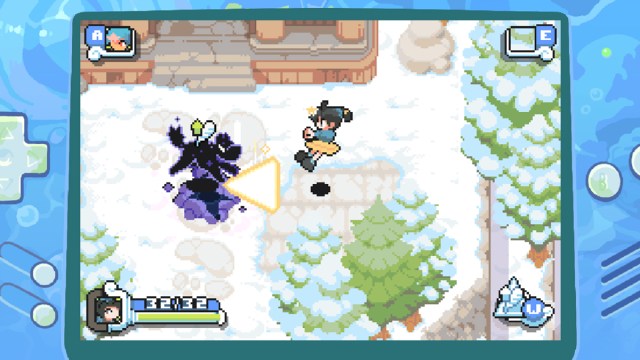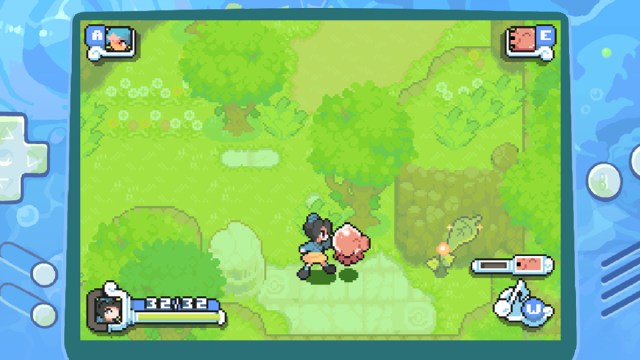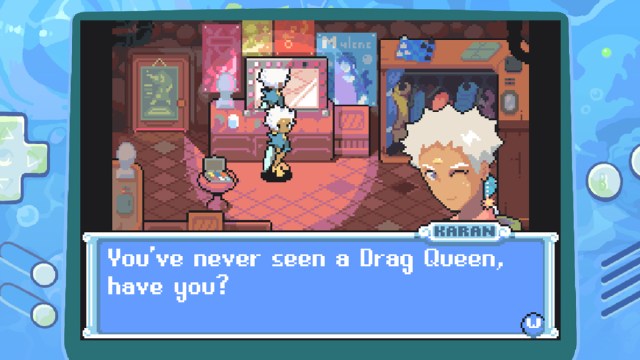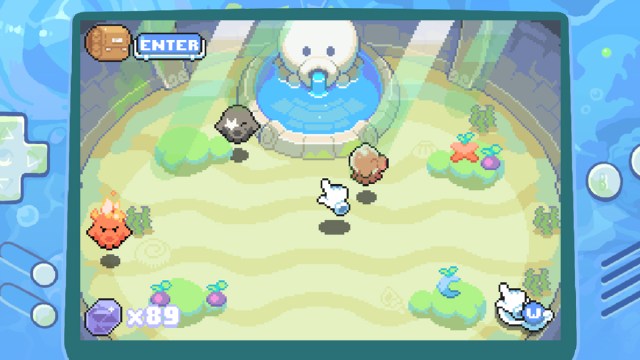Octopi and secrets and drag, oh my!
The era that arguably made me the gamer I am today was the three-and-a-half-year span the Game Boy Advance ruled my life. I was 16 when it was released, and it was the first video game device I purchased with my own money. I didn’t have to wait for a birthday or holiday. The September after it first dropped, I took the bus over to the next town and dropped around $150 on the indigo purple version along with copies of The Legend of Zelda: Oracle of Seasons and Super Mario Advance. Five days later, I would return to the store to get a light for the screen because it was dark as hell.
That was a difficult year for me. Having a GBA got me through some very tough times. The toughest of which was my move from Washington to California. A new city. A new school. Having to start from scratch to make friends. It wasn’t easy, and I spent more time than I’d like to admit with my nose inches away from my Game Boy Advance screen rather than being around other people. Because it was there for me at such a pivotal point in my life, there isn’t another gaming device, handheld or otherwise, that brings me as much nostalgic joy.
I’m always looking out for games that can transport me back to that time in my life—even though I’m well aware that recapturing your youth is impossible. I just like the look and feel of games from that generation, which is why for the past week, I’ve been infatuated with Tako no Himitsu.
Tako no Himitsu is the second game from Christophe Galati. About five years ago, I corresponded with him about his first game, Save me Mr. Tako!, in the weeks leading up to its release. I was hopeful for the game, but the release version of the game wasn’t up to snuff. Some behind-the-scenes drama between publisher Nicalis and Galati ensued, and a few years later, Galati re-released Save me Mr. Tako: Definitive Edition with the assistance of Limited Run Games.
“I had to pause everything in order to re-release Tako as a Definitive Edition,” Galati explained, “even though I was told to give up and move on. I’m proud I did it even though it was like starting over. Thanks to the Limited Run Physical version, the game is finally earning me money, four years after its original release.”
I can’t imagine the difficulty of making one indie game, let alone having to make it again. But that’s what Galati did. It was a massive undertaking. But he wanted to save his original vision for Tako, which was to pay homage to the various gaming generations that helped him growing up. As he told me in our first interview, Galati got his Game Boy Color right around the time I got my Game Boy Advance.
“I ended up getting the Game Boy Advance not too long after, when I was nine I think. It became a really important part of my teenage years,” Galati said.

As it did with many, the GBA had a profound effect on Galati growing up. He said he got it when he started developing his own tastes and didn’t have to rely on his older brother’s game collection for something to play. He could actually ask for games he wanted to play or buy them with his allowance. It was during these years he discovered his love of the RPG, and if there is one thing the Game Boy Advance had no shortage of, it was quality RPGs.
“The GBA is the platform where I experienced Final Fantasy for the first time, starting with Dawn of Souls (I & II), then IV, V, and VI, which stayed my favorite of the series,” Galati said. “I spent a lot of time playing Golden Sun, which also became one of my favorite games. A friend lent me a small guide at school to find all the Djinns, and I remember the hype when I discovered Golden Sun II (The Lost Age).”
He cites many other classics of the era, including Fire Emblem: The Sacred Stones, Castlevania: Aria of Sorrow, and Final Fantasy Tactics Advance. Those titles and more are helping shape Galati’s ambition with Tako no Himitsu. But it’s two specific games that are at the root of his inspiration.
A clear inspiration
“Illusion of Gaia had a huge impact on me growing up. Quintet Studio’s games had this kind of melancholy around them, a very unique aura,” Galati says. “I took inspiration from that and wanted to create a simple action RPG with kind of a lite aspect in terms of mechanics and items, like Terranigma, but with many playable characters and a unique mood. Golden Sun also inspires me a lot due to his awesome gameplay. Its psynergy feature directly inspired the Tako no Himitsu magic system, as you can pair characters with an octopus that can use magic spells both in battle and for exploration puzzles. I hope I can do really cool dungeon puzzle design, as well as hiding a lot of secrets in the world.”

So what exactly is Tako no Himitsu? On his pitch deck, Galati describes the game as an action RPG whose gameplay and aesthetics are inspired by the Game Boy Advance. In the game, players will take up a party of characters with unique movesets who can be paired with octopi that grant magic skills for combat and exploration. Galati’s description notes Tako no Himitsu will have simple gameplay and combat against a legion of shadow monsters, a rich world filled with secrets to explore, and a story that explores how secrets impact us and those around us.
“The code name of the game was Himitsu Project right from the start,” Galati explains. “Himitsu means secrets in Japanese, which was handy because I kept the heart of the project secret for a long time, but also because ‘secret’ is the main topic the game is dealing with (for both the characters and the world). The goal of the game is to explore how secrets become shadows in people’s lives, and how people in power use them to rule the world. Tako no Himitsu can be translated as Secret of the Octopus. It was hard picking a name, because as a sequel it needed to have Tako in it, and the team got attached to Himitsu, so why not keep both? As the game development started in Japan, having a Japanese name was also a cool nod to its roots.”
Five months at the Villa Kujoyama
The origins of Tako no Himitsu can be found far away from Galati’s native France. Following Galati’s fallout with Nicalis, he applied and was accepted into a French Artist Residency program that sent him to Kyoto, Japan. It was here, at Villa Kujoyama, that Galati would heal from the less-than-stellar launch of Save me Mr. Tako!, commit himself to revising the game for the Definitive Edition, and set about on the sequel.
“I ended up pretty burned out and a bit disgusted by the game industry I would say,” Galati says. “Spending time at the Villa Kujoyama in Japan really helped me to heal, it gave me the determination to save Save me Mr. Tako! and continue making games. I had to fight abuse my whole life so giving up was not an option for me. It’s very hard for marginalized people and I want to prove to myself that I can exist in this industry.”
Galati documented his life at Villa Kujoyama in a Medium post that detailed his five-month stay. It’s an interesting summary of food, the Japanese indie scene, and the first stages of development for what would eventually become Tako no Himitsu. Galati says this spiritual sequel to Save me Mr. Tako! will be a lot more personal and take inspiration from events in his life.
It will also take inspiration from the people in his life. One of the playable characters in Tako no Himitsu is Karan, a drag artist. I was curious about the inclusion of Karan in the game and if Galati was aware of the incredibly stupid and dangerous push in the United States to rebrand and ban drag performances as some sort of sexual act.

“I’m pretty much aware of what is happening in the US regarding Drag Ban laws, and sadly the same thing is starting to happen in France too,” Galati says. “I was introduced to this art form in 2016 by my friend Mirage who was starting drag at the time. It was before RuPaul’s Drag Race became available on Netflix, it was less mainstream so I had to follow her to small dark bars in the middle of the night in Paris, I’ll never forget this magic. I stayed close to this world and wanted to portray it in my game. I already put some queer representation in Save me Mr. Tako!, but I want to go a step further this time with a queer main character as I think it’s important to do my part in representation, especially with everything that is happening right now. I stayed in touch with many drag artists from all over the world in order to portray the drag scene properly in Tako no Himitsu. Karan was also inspired by people I dated in my life, he will be very important in the story.”
Karan will be just one of several characters players will take control of throughout the adventure. Galati says he is taking a Final Fantasy VI approach to the narrative where there isn’t one main character but a large cast who have their own struggles. I’m curious about all the characters revealed so far, but I’m also interested in how the game will incorporate the octopi.
Imagine a world with no takoyaki
Tako no Himitsu takes place roughly 800 years after the events of Save me Mr. Tako! While that game ended on a positive note, the years between the two titles reveal whatever peace was achieved at the end of the first game didn’t last long, and octopi were soon wiped from the world. In Tako no Himitsu, the characters you take control of will discover there are octopus heroes who survived extermination and are ready to assist them in their world-saving adventure. Taking inspiration from Golden Sun, players can expect to use their octopus pals in combat and environmental puzzle solving. The octopi you collect can be raised and powered up by spending time with them in the Octopus Garden Tako Fountain.
“I played Sonic Adventure 2 on the Gamecube a lot, the Chao Garden definitely inspired the Tako Fountain feature in Tako no Himitsu,” said Galati. “In order to use magic spells, you have to pair characters with octopuses. The goal of the garden is to increase your bond with octopuses and make them stronger. By fighting shadow monsters, you’ll get shadow gems that you can throw in the fountain to make fruits grow and feed your octopuses. There are also a few other items you can use there to boost magic and stuff like that, the mood of your octopuses as an impact on the spell power. I can confirm already that you can pet octopuses in Tako no Himitsu!”

All of this sounds right up my alley, and seeing the game in motion is like gazing into a past I’d much rather be in than our current present. Galati is aiming for a 2025 launch for Tako no Himitsu on PC and consoles, including whatever Nintendo device is out in the world at that time. He’s also not doing it alone this time around. Galati has teamed up with a small group of artists, including Valentine Seiche, Pixel Boy, and Challenger.AAA to develop the art for the game. Having a staff means having to cut checks. Galati has secured some funding already, but more is needed to fully fund the project.
Later this year, a Kickstarter campaign for Tako no Himitsu will launch with a 50,000€ goal. His ultimate goal is to move away from being a one-man-band indie developer and actually having a team work with him at his studio Deneos Games. A team would give Galati the ability to make bigger, bolder, and hopefully queerer games. It would also help him take the logical next step for his Tako franchise. If this series is to pay homage to the handheld eras of the past, then a sequel to Tako no Himitsu would jump us to the Nintendo DS, right?
“Who knows what the future holds! I have a pretty good idea of what my next game will be, but first, we need to finish the development of Tako no Himitsu,” said Galati. “What I can say is that I’d love to make a game with a 2D/3D mix like it was done in Grandia and Xenogears.”
The Kickstarter page for Tako no Himitsu is now available, and the game is available on Steam to wishlist. Galati hopes to launch the game on PC and consoles—though he is just focusing on PC right now—in Q2 of 2025, with a demo in Q3 of this year.






Published: May 17, 2023 11:30 am